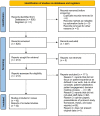Studying both patient and staff experience to investigate their perceptions and to target key interactions to improve: a scoping review
- PMID: 36216415
- PMCID: PMC9557797
- DOI: 10.1136/bmjopen-2022-061155
Studying both patient and staff experience to investigate their perceptions and to target key interactions to improve: a scoping review
Abstract
Objective: The improvement of patient experience (PE) is related to the experience of staff caring for them. Yet there is little evidence as to which interactions matter the most for both patients and staff, or how they are perceived by them. We aimed to summarise the interactions and the perceptions between patients and staff from studies by using both patient and staff experience data in healthcare institutions.
Design: Scoping review.
Methods: We conducted a scoping review, including studies dealing with PE and staff experience. Two authors independently reviewed each title/abstract and the selected full-text articles. A list of variables (objective, study design, data sources, tools used, results, interactions, perceptions and actions) was charted and summarised using a narrative approach including both qualitative and quantitative data. Studies were grouped according to their objective and the key interactions summarised according to this stratification. The perceptions of patients and staff were identified in the results of selected studies and were classified into four categories: commonalities and disagreements of perceptions, patients' perceptions not perceived by professionals and professional's perceptions not perceived by patients.
Results: A total of 42 studies were included. The stratification of studies by type of objective resulted in six groups that allowed to classify the key interactions (n=154) identified in the results of the selected studies. A total of 128 perceptions related to interaction between patient and staff were reported with the following distribution: commonalities (n=35), disagreements (n=18), patients' perceptions not perceived by professionals (n=47) and professional's perceptions not perceived by patients (n=28). We separated positive and negative perceptions, which resulted in seven scenarios, each with actions that can be carried out for one or both populations to overcome barriers.
Conclusion: The study of both patient and staff experience allowed the identification of actions that can be taken to change the perceptions of patients and staff.
Keywords: education & training (see medical education & training); health & safety; health policy; organisational development; public health; quality in health care.
© Author(s) (or their employer(s)) 2022. Re-use permitted under CC BY-NC. No commercial re-use. See rights and permissions. Published by BMJ.
Conflict of interest statement
Competing interests: None declared.
Figures
References
-
- Wolf JA, Niederhauser V, Marshburn D. Defining patient experience. Patient Exp J 2014;1:7–19.
-
- Christensen T. Rebalancing the patient experience: 20 years of a pendulum swing. Patient Exp J 2017;4:6–8. 10.35680/2372-0247.1257 - DOI
-
- Wolf JA. Consumer perspectives on patient experience 2018. The Beryl Institute, 2018.
-
- Dawson J. Links between NHS staff experience and patient satisfaction: analysis of surveys from 2014 and 2015. NHS 2018.
-
- Maben J, Peccei R, Adams M. Patients’ experiences of care and the influence of staff motivation, affect and wellbeing. NIHR 2012.
Publication types
MeSH terms
LinkOut - more resources
Full Text Sources
Medical

